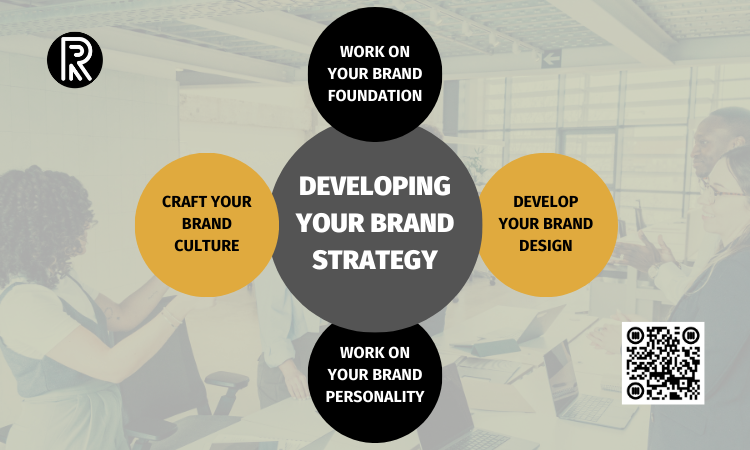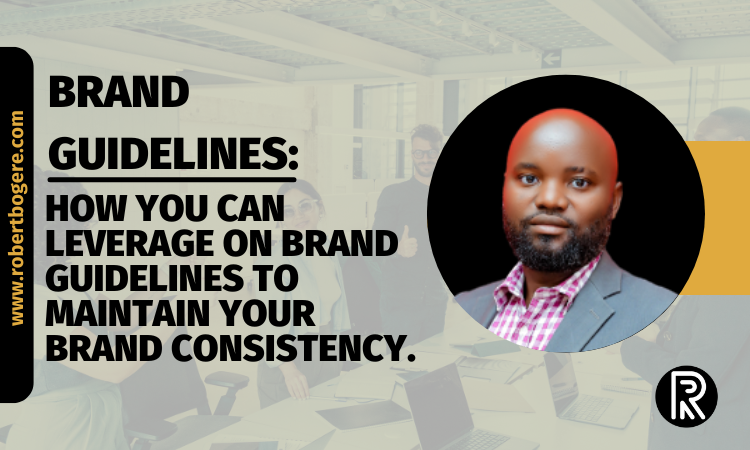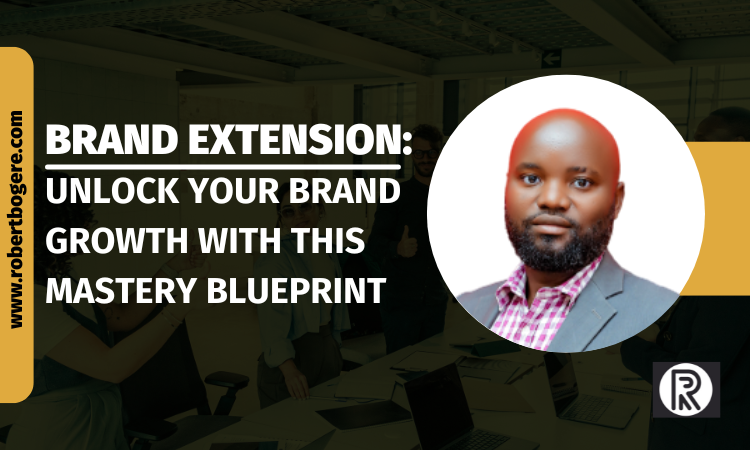Last Updated on Wed-Mar-2024 by Robert Bogere
Are you looking for a brand strategy approach? Want to increase your revenue and have stronger relationships with your target customers?
In this modern era, where many brands fight for consumers’ attention, growth hinges on more than just quality products or services. It requires a crafted symphony of perceptions, emotions, and experiences—the influence of brand strategy.
The above in Startups. It’s difficult to identify such energy and commitment to developing a brand with start-up brands.
Need to know how to craft your brand values for your brand? Read here!
It’s where I spotted a gap and started showing up to assist Start-up brands in identifying their brand areas of improvement—address and offer brand growth customized solutions.
For such brands, I saw a brand strategy as a window covering. Start-ups focus more on appearance and expression, though it ought to be substance and value.
With the power to know why you exist, differentiate, position, and foster loyalty, a well-defined brand strategy acts as a north star guiding a company’s journey through a sea of choices.
From experience, developing a brand strategy is a challenge to many leaders since it’s something that changes.
In this article, you’ll learn what is a brand strategy, the elements of brand strategy, how you build a brand strategy, and a brand strategy example of a prominent brand.
But wait,
- What is a brand?
- What is a brand strategy?
- Elements of brand strategy
- How do you develop a strong brand strategy?
- Brand foundation
- Carry out your target market research
- Work on your customer journey
- Carry out your competitor research
- Develop your brand messaging
- Craft your brand positioning statement
- Work on your brand voice
- Work on your brand tone
- Identify your brand essence
- Develop your brand value proposition
- Craft your brand story
- Create your brand identity
- Work on your brand architecture
- Develop your creative brand guideline manual
- Brand Strategy Example
- Brand strategy summary
What is a brand?
Before you know the rationale of brand strategy, you need to know what a brand is.
A brand encompasses all the things that make you stand out from competitors as different.
“A brand is the set of expectations, memories, stories, and relationships that taken together, account for a consumer’s decision to choose one product or service over another”—Seth Godin
That brings you to;
What is a brand strategy?
Brand strategy is set up on a platform of differentiation where a company can use its value proposition to create competing advantages and satisfy customer needs—Martech.org
Marty Neumeier defined a brand strategy as a plan for the systematic development of a brand in alignment with a business strategy.
Put, a brand strategy is your decision on what you want to stand for: the associations you want to build in people’s minds.
It helps you know who you are and acts as a blueprint to help you communicate it. Being a leadership role, brand strategy should help build relationships with your stakeholders, employees, customers, suppliers, and community leaders.
Without a proper brand strategy, you’ve problems with understanding your brand purpose, vision, mission, and values, leading you to poor decision-making and a stagnant brand in the marketplace.
Developing a strong brand strategy takes time, effort, and commitment. That’s where many Start-up brands get stuck. Many Startups after receiving investment funds, start building their teams and penetrating new markets without first working on their brand strategy.
Elements of brand strategy
Before you develop your brand strategy, be clear about what you’re creating and why, and ensure the right people are engaged in the entire process.
When considering building your brand strategy, there are elements you need to know that govern your process. These act as a guide to what to do, as below;
Brand Story
Your brand story is a narrative you apply to communicate essential moments in your business—originality story, beliefs, values, the purpose of your business, etc.
Your brand story increases the emotional connection between your business and customer base. To know if your brand is in the right direction when it comes to brand strategy is to think of your strategy as a story you’re telling.
It helps motivate consumers to think, feel, and act while it works and establishes the ideal brand’s reputation to be in the minds and hearts of your consumers.
An example is myself. My brand story takes center stage—sharing WHY I exist, HOW I started my journey, and WHERE I got the courage and inspiration. All that can be read in my story.
A nice information isn’t just a narrative to read. It’s an experience that needs to be with a start, middle, and ending. At the end of your experience, there must be results and lessons different from your beginning.
By sharing WHY you exist, WHAT you stand for, and WHAT inspired you to start, you develop an emotional environment where your would-be customers get to know your brand on a deeper level.
From the above, your brand strategy brings you to one thing—brand storytelling. Your brand strategy should be all about your story — purpose, mission, vision, values, beliefs and behaviors, spirits, personality, etc.
When it comes to brand strategy, there are common questions prominent brands answer—WHY do you exist, WHAT do you do? WHO are you and HOW do you do things? How do you want to appear, feel, and sound?
Read more about brand storytelling
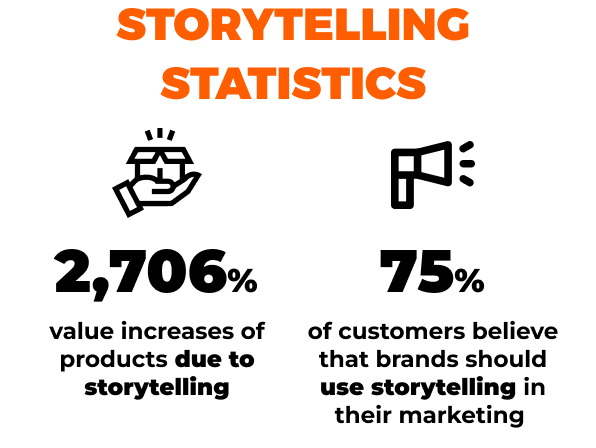
Brand Culture
Brand culture and company culture are attached, but different. In building your brand strategy, you need to develop the heritage to fuel the future. You need to understand your heritage and culture that will make your brand successful while spotting what will keep you pushing forward.
With your brand culture, think of the relationship between your products and those who purchase them.
Developing your brand values provides you with a strong direction and purpose. Following and communicating your values allows your target audience to connect with your values and buy your products if your values resonate well with them.
Brand values are your parameters or gauges to help you discern if your team’s decision fits your brand goals. They also build relationships with your community and find potential customers who share similar beliefs.
In developing your brand values, you need to think of certain questions—What matters most to you? What causes is your brand working on? What do you believe in as a brand?
Answering such questions helps you know the heart of your brand values, beliefs, and principles that should guide your business.
As Allen Martinez said in his article, “we measure The quality of a brand at a high level with attributes like—culture, values, reflection, personality, archetypes, promises, reward benefits, reason to believe, advantages, discriminators, and differentiators”
Brand strategy is about who you want to be and what you’re trying to say. Is what you say what you do?
For example, you find a brand having integrity as one of its brand values, but in the end, it takes shortcuts to take its sales orders. That means integrity isn’t their value instead, they’re after winning.
Brand Design
Think of questions like; How visually do you want your brand to show up? The brand design draws an emotional response from your target audience.
Developing the visual elements of your brand—from identity to packaging offers a stronger position in the marketplace. It also improves your customer experience, creates a strong visual identity, and can help differentiate you from your competitors.
What makes a good brand? It’s more of having visual elements or a strong brand story. Think of the principal characteristics—visuals like brand logo, typography, tone of voice, composition, imagery, motion, etc.
Such helps to identify your brand and a sea of competitors. As you develop your purpose, you’ll find your brand system, which is the visualization of your brand persona.
Your brand’s success is associated with having the right creative message. With brand strategy, it’s more of the designing of experience, which is more intuition-based human, empathetic, and end-to-end experience.
If your brand is among the least creative brands, you need to think twice about your brand strategy.
Brand Personality
Think of your brand as a person – a living thing. Your brand voice informs the kind of brand messaging the brand uses. A strong brand voice may remind you of your sarcastic best friend, kind teacher, or reassuring doctor.
Every person has a unique personality, so does every business. Having a forgettable brand can help to envision your business as a person. If your business was a person, what kind of person would it be? What traits and characteristics would make it appealing?
With personality, you set your tone for the relationship that a customer will build with a brand over time and show them what they can expect from it.
Think of the phrases and words a brand uses to communicate with current or new customers across many communication channels.
How does your brand sound and speak? Try to make your brand voice unique. How do your competitors sound? How can you modify or improve your sound?
Think of how you make your statements, words you use or don’t, slang and jokes you use. How do you speak? How would our customers describe your voice, tone, and style?
Another thing you need to think of is brand personality, think of a brand vibe—a sentiment you exist on your brand touch points and channels like website, social media channels, product packaging, etc
Think of anything from playful to sarcastic to serious to funny, creating a vibe that contributes to the overall customer experience with your brand and it can leave a more memorable, lasting impression.
The above elements are what make your brand so strong from other competitors in the marketplace.
How do you develop a strong brand strategy?
Brand strategy isn’t for marketing people and it doesn’t only help you sort your brand logos, colors, copy writing, and imagery. It’s beyond that.
Forget about the many templates or frameworks from various specialists. Before you start on your brand strategy development, you need to be clear about what you’re crafting and why.
Ensure the right leaders are all engaged in the entire process to agree after the entire process.
Your brand strategy documentation should cover things — purpose, vision, mission, beliefs, values, attitudes, audiences, value proposition, and positioning. Think of assembling documentation to work as a guide for every decision you make in alignment with your brand.
Brand foundation
Define your brand. Think of answering questions like WHY does your brand exist? What kind of problems does it solve? WHO are your competitors? Who are your ideal customers? HOW does my brand make customers feel? What is the story behind your brand—originality?
Answering the above questions guides you to where your brand is heading — your brand direction. Every prominent brand you see has a basic set of things it believes in, such as guiding and influencing your team’s decisions.
Brand foundation includes things like;
Purpose—WHY does your brand exist?
Vision—WHAT future are you looking at? What does your brand’s future hold?
Mission—How will you develop the above future?
Values—What beliefs or principles guide your decisions and behaviors?
A sound foundation from the start because it guides you in making your goals, targets, and decisions for the corresponding future.
Carry out your target market research
Think of developing your customer persona. A customer persona is a well-detailed description of the ideal buyer who wouldn’t be able to resist buying your product or service. Such will support you to know the kind of customers you’re targeting with your marketing messages.
You can’t have an emotional touch when you don’t know whom you’re trying to connect with. Figure out how your brand is or how it could serve the needs and desires of your stakeholders.
Work on your customer journey
When developing a brand strategy, you need to think of the journey your customers pass through to make a purchase. Customer journey—a map that shows a customer is connecting with your brand at specific moments. It ranges from not connected at all—to loyal advocates and repeat customers.
Carry out your competitor research
Your strategic choices depend on market opportunities to build on your core strength create a bond with consumers and battle competitors. It’s good to know how your competitors connect with their audiences.
You don’t need to copy what your competitors do. Instead, you can learn from what’s working and where they’re having weaknesses in building their brands.
Looking at your competitors can give you strategic inspiration and insights to help you set yourself apart from the crowd. Competitor analysis will help you know what specifically differentiates you from competitors. You’ll need to focus on what makes you different at the time of developing your marketing messages.
Develop your brand messaging
Now you know why you exist and know who you are. Next, work on your brand essence — how to express who you are and messaging. When you work on such issues, your brand will communicate consistently and authentically.
Many brand consultants skip this stage and jump straight to working on the brand designs—identity and other stuff, but such should be the one to direct you to the designing stage.
Others first work on the designing stage and then start on the foundation stage—this is also not in moral order.
Develop your brand personality—essence, voice, tone, positioning
Remember, I asked if you were a person, which kind of person would you be? Your personality is your brand’s human characteristics and traits.
Think of who are as a person. Are you always a serious person, playful, professional, formal, curious, elite, or sophisticated? Select a personality that reflects your brand foundation.
Craft your brand positioning statement
As you’re developing your brand messaging, the brand positioning tool at your disposal is to begin with a benefit ladder that takes you from the base customers’ problem through the various benefits.
Once you’ve brainstormed all your brand benefits, it’s time to develop a single guiding brand positioning statement that links with every aspect of your brand while supporting the emotional benefit you offer your target customers. Having such a statement ensures brand consistency across all touch points.
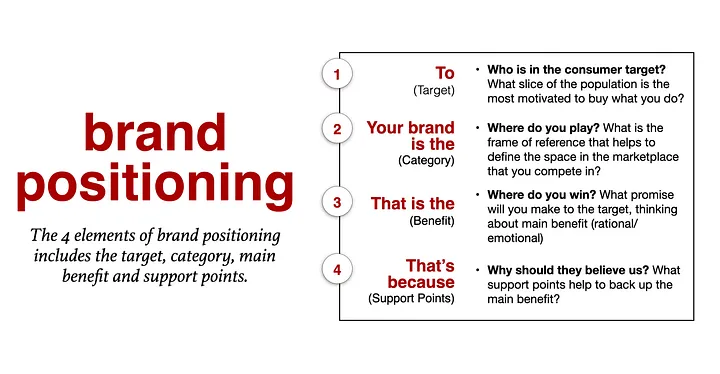
Work on your brand voice
Think of the way your brand speaks and sounds. Check how your competitors sound. How can you differ from them? You don’t need to copy your competitors instead. See how you can modify your sound to make you different.
How do you speak? Think of how you should make its statements. The dos and don’ts. There are words you may want to evade—think of negative words. You may say I want to use only positive words—mention those positive words you want to use.

Work on your brand tone
The best way to develop a pleasant tone, think of how you want your target customers to feel—a straightforward or helpful brand. It’s advisable your select 3 words to describe your tone.
Identify your brand essence
Some claim it is a tagline, mantra, slogan, etc. Don’t be dragged away by different words. What makes more people get lost are the words.
Your brand essence is a simple sentence, phrase, or word used to summarize a market position. Think of brainstorming such statements and go on to filter to more fascinating statements that resonate with your brand.
Those words or phrases should be from 2 to 3 words maximum. For example—Airtel’s new tagline is A Reason to Imagine and the older one was “The Smartphone Network” and one for MTN is “Everywhere You Go” for Nike—Just Do It.
At Airtel, we see this growth as a beautiful thing. This is why our new brand purpose represents our commitment to the future. It is about youth, about excitement, about fun, and most of all, about imagination.
Carl Cruz, Airtel Nigeria
Develop your brand value proposition
Brainstorm both the functional and emotional benefits your products provide to your target customers. Think of the way you want to solve your customers’ problems and why customers should choose you over your competitors.
As advised not to be taken away by words—some experts call value proposition a promise. It’s what your brand messaging will ultimately support and reinforce.
Craft your brand story
Think of your brand originality or founder’s story. Your brand story aligns all brand communications with all media options. It helps motivate consumers to think, feel, and act while it works and establishes the ideal brand’s reputation to be held in the minds and hearts of the consumer.
Create your brand identity
Now you know who you are, why you exist, and brand messaging. It’s time to visualize it with the basics. Think of how your goals connect with your customers. How does your mission address your customers’ problems?
Brand strategy is key when deciding on visual branding as it’s when developing your brand messaging. As you transform from your purpose to impact, you’ll find your brand system, which is the visualization of your brand persona.
Think of your brand logo, tone of voice, colors, composition, imagery, typography, and motion. How do you make branding actionable while ensuring brand consistency?
Work on your brand architecture
If you have many products, try to develop economies of scale by tying your diverse brand assets to your parent brand. Make it easy for your customers to navigate through what you offer.
There’re many architecture frameworks you need to look at and see what resonates with your brand. That’s according to the diverse products you offer. Reinforce your products or services that are your biggest sellers.
Develop your creative brand guideline manual
Now you know your brand and target customers on a deep level. It’s time to work on how you’ll deliver your message, and apply your brand identity and other stuff.
Develop rough design concepts and scripts to help envision what your brand could look like. This is the stage at which you’ll learn to creative apply your brand logo design, the fonts, typography, and how to use or apply them—whether center, left, or right, brand colors, imagery you need to use.
When your target audience gets linked to your brand, they’ll no longer consider your brand values because they know them. Now they recognize your brand colors, logo, fonts, etc.
Brand Strategy Example
Let’s study one of the world’s prominent brands, Apple, which is currently valued at US$880 billion, maintaining its position for the 2nd year in a row – according to the just-released Kantar Brandz most valuable Global brands report, 2023
Since brand strategy is about;
WHY does your brand exist?
WHO are you and HOW do you do things?
How do you look, feel, and sound?
What does your brand do?
Let’s look and see how Apple answered such questions. This is how Apple defined its brand.
WHY does Apple exist?
For me, it’s about products and people. Did we make the best product and did we enrich people’s lives? If you’re doing both things and those things are strangely linked because one leads to the other, then you’ve a good year
Tim Cook
Their answer to the question is “To build the best products in the world that enrich people’s lives”
Lots of changes have happened, but the reason for their being hasn’t changed.
WHO you are—Apple brand values
We’re a collection of people in Apple that want to change the world for the better. We want to leave the world better than we found it. And to do that, you’ve to be a part of the conversation in areas where the policies of government intersect with your values. Racial equity and justice are a part of that. Diversity and inclusion are a part of that. The environment is a part of that. Supplier responsibility is a part of that
Tim Cook
Apple articulated various values that underpin how they are changing the world for the better, as below;
- Education
Education is the great equalizer and a powerful source of opportunity for all.
- Environment
Our goal is to leave the planet better than we found it
- Accessibility
Technology is most powerful when everyone can make their mark
- Inclusion and diversity
We are committed to making Apple more inclusive and the world more just.
- Racial equity and justice initiative
This is a long-term effort to help ensure more positive outcomes for communities of color.
- Privacy
We design Apple products to protect your privacy and give you control over your information
- Supplier responsibility
We believe in a safe, respectful, and supportive workplace for everyone.
HOW does Apple look, feel, and sound?
The first thing we ask is, what do we people to feel?
- Delight
- Surprise
- Love
- Connection
Then we move ahead to craft around our intention.
It takes time. There are a thousand NOs for every YES.
We simplify, we perfect, and we start over until everything we touch enhances each life it touches.
Only then do we sign our work. Designed by Apple in California.
Only 3 words in specific direct HOW Apple look, feel, and sound.
- Simplicity
- Creativity
- Humanity
“If a product is not made up of these things. It’s not Apple,” – Tor Myhren, VP of Marketing Communications, Apple.
WHAT Apple does—What do you do?
They do hardware, software, and services—that’s computers, phones, retail, TV, etc. This can change, but they’re WHY, WHO, and HOW don’t.
While marketing and products change, the values and core beliefs that underpin your company shouldn’t. You’ve to be clear on WHO you’re and WHAT sort of people are going to help you build your brand
Steve Jobs
Brand strategy summary
In such a competitive space, a brand is much more than just a logo or a product/service. It embodies the essence of a company and the emotions it evokes in the target consumers.
A brand strategy is a deliberate plan that shapes this perception, comprising a collection of elements like brand identity, messaging, target audience, and competitive positioning.
Developing an effective brand strategy requires you to know the market dynamics, consumer preferences, and company values.
For instance, Apple’s brand strategy masterfully melds simplicity, innovation, and exclusivity. Their sleek design, user-centric ethos, and seamless integration exemplify the power of a meticulously developed brand strategy.
In essence, a robust brand strategy is the compass directing a company’s journey through the competitive landscape, fostering customer loyalty, and differentiation.

